
A Resilient Demand Planning Framework

Yulia Fedorova
16 May 2022
Recent demand disruptions have put global supply chains to the test. The surge in demand for certain goods in healthcare, consumer goods, or e-commerce led to many "firefights" in the supply chain. Combined with global supply shortages, an increase of 250% of out-of-stock situations in October 2021, compared to a pre-pandemic period (January 2020), are the results, according to Adobe [2].
Also, structural changes like increasing sales channels make demand planning more and more challenging. According to a study, sales channels increased from avg. five to ten over the last five years with a considerable shift from offline to online channels. More frequent new product introductions and sales promotions are an additional tricky impact driver on demand planning processes.
That questions whether traditional demand planning frameworks are still valid in these volatile times. Therefore, it is necessary to revise demand planning design principles like
- Forecasting Granularity
- Forecasting Horizons and Time Buckets
- Demand Planning Technology Stack
- Demand Planning Metrics.
These design principles should be integrated into a Demand Planning Target Operating Model, considering multiple dimensions. Let's have a look at these different demand planning principles and recent developments.
Forecasting Granularity
The first step to an effective planning process is determining the level of granularity. There are two types of granularities: demand-driven and supply or product-driven.
Each type includes several dimensions on which demand can be planned. The decision should be based on how your supply chain is constructed on the supply side. So, who is the recipient of the forecast? On the demand side, an analysis of whether a new forecast hierarchy adds additional value, e.g., more accurate forecasts. Or is a more aggregated level with less effort sufficient to generate high accuracy forecasts. These are the guiding questions when defining the forecast granularity.
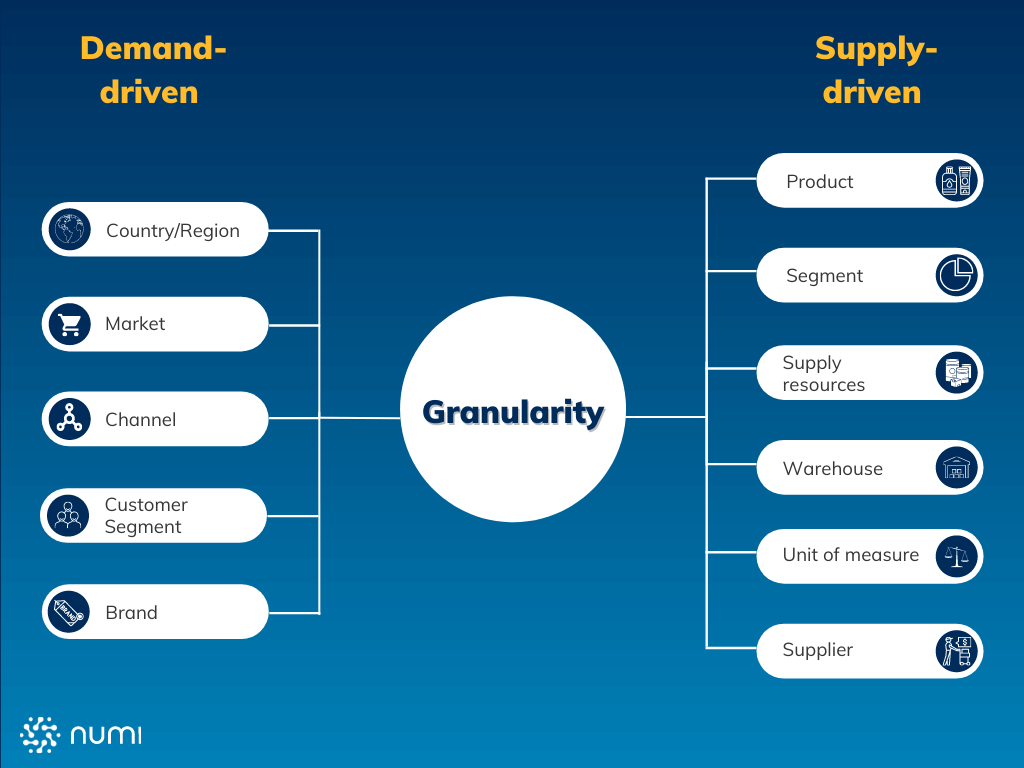
There are plenty of options for defining the right level of granularity. In each case, the decision on the granularity level should be made separately, based on supply chain structure, business needs, and available input data.
However, recent volatility in demand requests rather for more granularity than more aggregation. The capability to aggregate and disaggregate between planning hierarchy levels becomes more critical to capture the impact of volatile demand signals at multiple dimensions.
Forecasting Horizons and Time Buckets
Another design decision is to choose the right forecasting horizon and time aggregation. The planning horizon should be linked to business needs. However, it is also essential to understand that the planning horizon should depend on what the supply chain is trying to optimize or achieve and what time is set to achieve these goals.
As for the timely aggregation, it needs to serve the needs of the forecast stakeholders. Annual financial forecasts must not be on weekly time buckets, but on the other hand, operational forecasts for warehouse or transportation operations require order level or daily time buckets. Process lead times like supplier replenishment lead times also impact the forecast horizon. For fast-moving goods with no production processes and a seven-day-lead time, an eight-to-12-week horizon is sufficient. Long raw material sourcing processes from Asia with complex manufacturing processes of the finished goods, a one to two years horizon is needed to plan supply capacities accordingly.
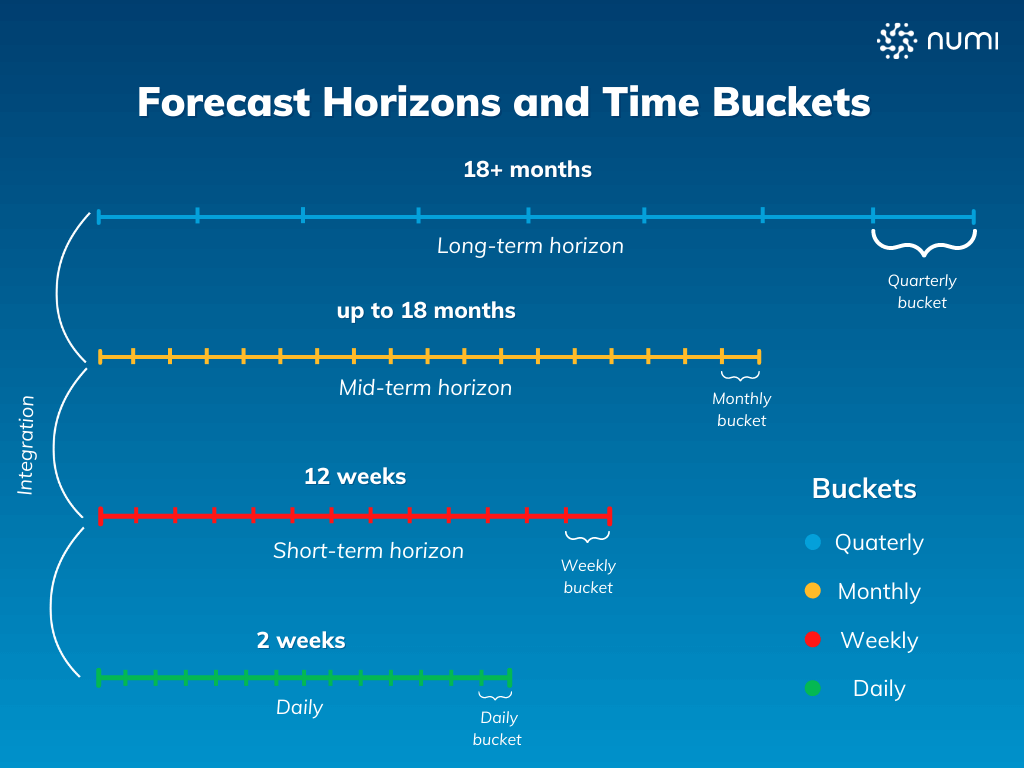
Different demand planning stakeholders might require different plans on different levels. Seamless integration between these plans is crucial to driving strategic and operational business decisions on the same numbers.
In recent times, we saw a shift to more frequent and granular time buckets to adopt faster to short-term disruptions.
Demand Planning Technology Stack
Many different methods and tools can support the forecasting process. State-of-the-art technology stacks help with many different facets of the demand planning process. External demand signals, New Product Introductions, Promotion Planning, Outlier, and Out-of-stock detections are just a few examples. Aligning different planning hierarchies and time horizons should also be managed by the right technology to enable a single source of truth for business-critical decisions.
Forecasting methods can be distinguished between "traditional" time series forecasting and machine learning methods.
"Traditional" forecasting methods have been available for years. These methods usually analyze the structure of a single time series, e.g., trend, seasonality, and residuals, and try to derive future predictions with this time series decomposition. One example is the well-known Holt-Winters Method [3]. These methods perform pretty well in setups with stable seasonalities and rich historical sales data. Bayesian and ARIMA approaches, on the other hand, consider the impact of prior information in the sales data. Therefore, they perform well in scenarios with frequent trend changes, volatile demand, and limited historical sales data.
Machine Learning prediction algorithms won all recent forecasting competitions on Kaggle [4] and outperformed traditional methods in terms of accuracy. However, applying machine learning methods in production on a daily or weekly basis can be quite challenging. It requires high input data quality and steady maintenance of the model parameter to achieve these high-quality outcomes at scale. Decision Trees like gradient boosting algorithms [5] usually provide high accuracies for time series problems when applied right.
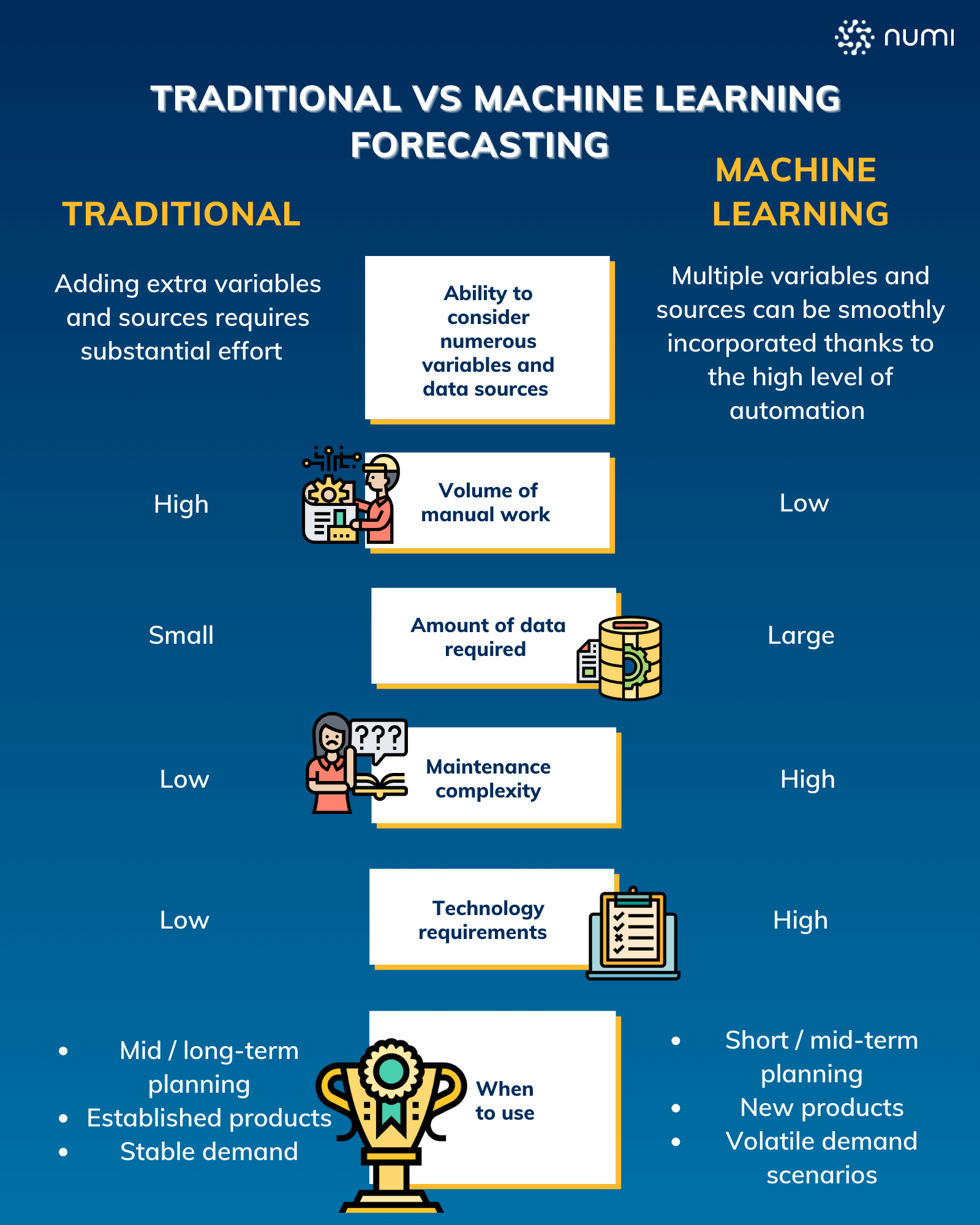
Most companies in the market use traditional methods for demand forecasting. However, lately, machine learning methods have been increasingly capturing the attention of companies and software providers due to the importance of external data to forecast future sales in volatile market environments.
Demand Planning Metrics
Forecasting metrics are important aspects of the demand planning process. The choice of indicators strongly influences the outcome of the forecast. Thus, with a weak RMSE, outliers will be given great importance, and with a weak MAE, there is a risk of a biased forecast. A combination of different KPIs might be a good idea to prevent this from happening. In the following, a non-holistic overview of different KPIs is provided, and indications of when to use them are given.
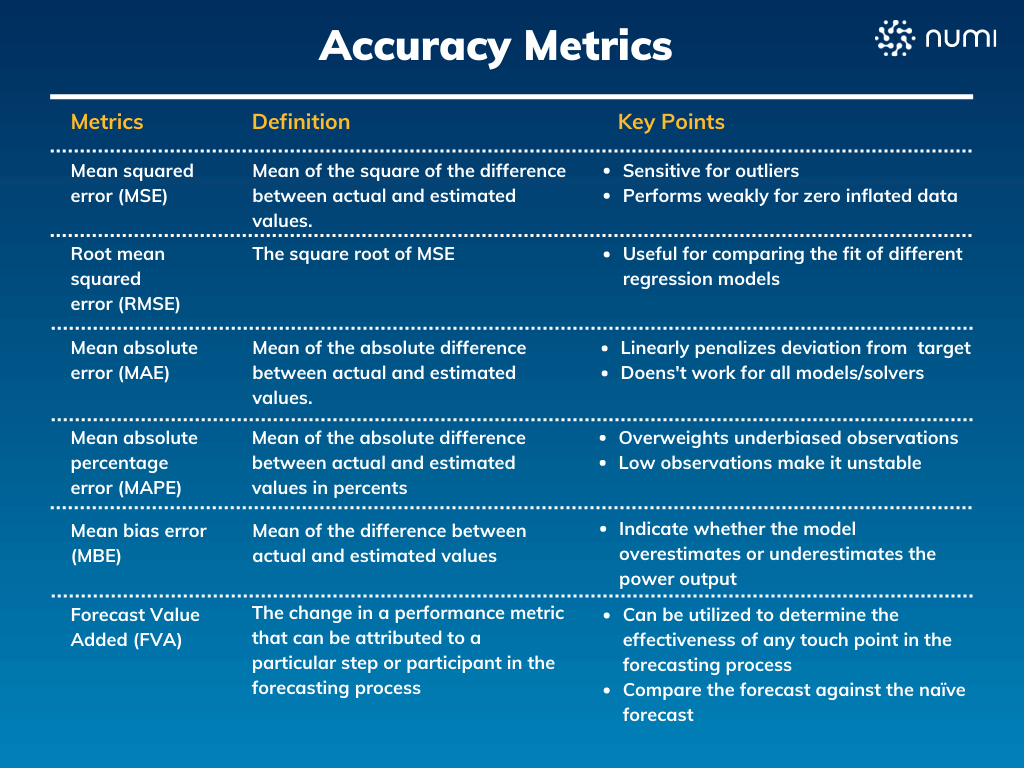
If your metrics for a particular element consistently deviate from the norm, then be sure to check your forecast method or process. Most likely, the forecasting process is misconfigured. It is also important to bring the KPIs of forecasting in line with the required horizon and time buckets.
One metric which can be used to set up demand planning frameworks is the Forecast Value Add metric. In the simplest form, it can validate if a change of a method or process adjustment brings additional value to the status quo or a simple forecasting method, e.g., a naïve forecast. But it can also be used if a certain design principle changes, e.g., to the forecast granularity, positively impacted business-critical KPIs, like lost sales.
Demand Planning Target operating model
The above design principles need to be embedded into a demand planning process, enabled by the right existing or new technology architecture and organizational setup.
Creating a robust demand planning process with the right degree of freedom to adopt on-demand signals in an agile way on the one hand and avoiding too much "noise" for upstream processes, on the other hand, need to be thoroughly balanced. Here, a good indicator is the forecast Value-add metric, which measures if an additional input, method, or stakeholder adds additional value to the forecasting process. To meet the new requirements of a more volatile environment, processes need to be designed to enable more frequent predictions with detailed demand driver analysis to better react to external disruptions. There is also a trend toward getting the inputs right and predicting a most likely future outcome based on these external inputs, considering inputs like Promotion-, CRM-and IoT- information. This is contrary to the approach of getting a baseline forecast and enriching the baseline manually by Sales, Marketing, or Product Management teams.
Technology also plays a crucial role in improving forecast accuracies. The right technology stack should include external demand drivers, enable "no-touch"/automated demand planning, and provide demand sensing capabilities to support New Product Introductions or Promotions planning. Technologies enable significant efficiency gains for demand planning teams and improve forecast accuracies.
Demand planning organizations have many different stakeholders: Marketing, Sales, Product Managers, and Finance, who provide demand signals. Correct predictions need to be provided to Logistics, Production, or Procurement on the supply side. For all these stakeholders, manual handoffs should be avoided and seamlessly integrated into the demand planning process. One critical question which needs to be answered here is who owns the forecast? With new technologies, new roles and tasks arise as well. Roles like data stewards, making sure the input data have the right quality, and demand planning data scientists, who develop and maintain forecasting models. External Partners, like Customers, can provide valuable information for the demand planning process. In some cases, it might make sense to collaborate with them on a joint demand plan.
Accurate and high-quality input data and forecasting metrics are the last building block of a resilient demand planning target operating model. The right level of granularity and timely aggregation, as described above, plays a crucial role here. External data, like Point-of-Sales data, CRM data, or IoT data, can also improve demand plans. The demand planning process can be monitored and steered with the right set of metrics so that the operating model runs at its optimum.
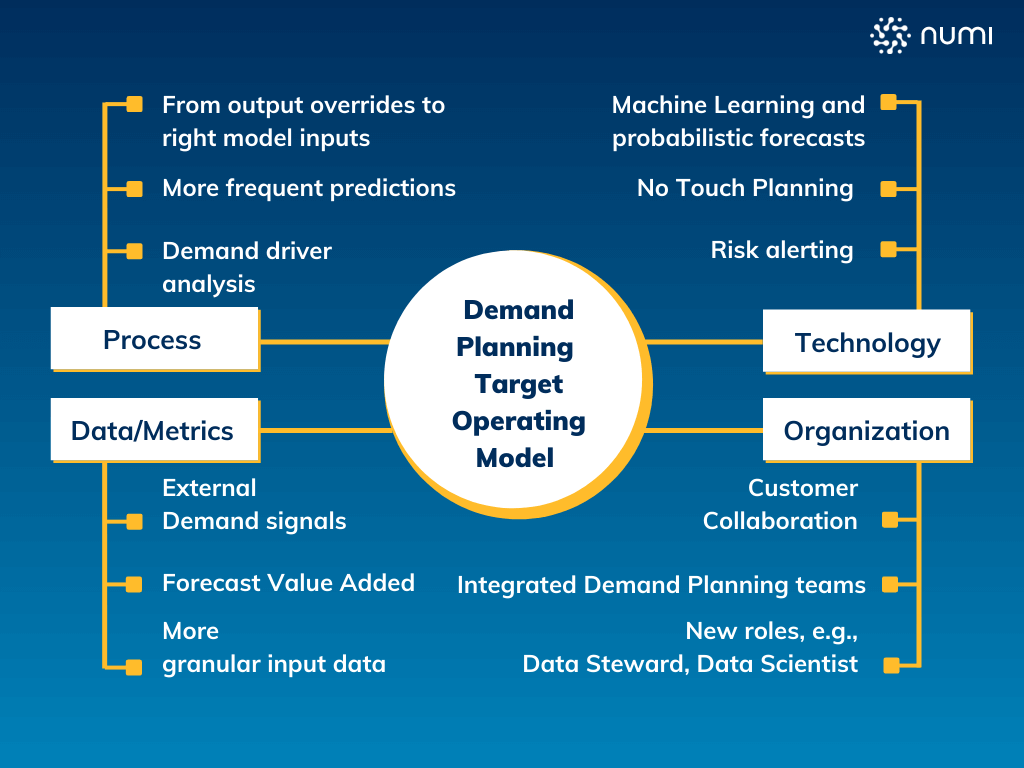
If you want to learn more about how numi can be embedded into your demand planning process, simply request a short introduction call.
Sources:
- https://www.mckinsey.com/business-functions/growth-marketing-and-sales/our-insights/b2b-sales-omnichannel-everywhere-every-time
- https://blog.adobe.com/en/publish/2021/11/09/adobe-shoppers-have-seen-over-2-billion-out-of-stock-messages-online-october-2021#gs.gn1jvf
- https://en.wikipedia.org/wiki/Exponential_smoothing
- https://www.kaggle.com/c/m5-forecasting-accuracy
- https://en.wikipedia.org/wiki/Gradient_boosting
- https://towardsdatascience.com/holt-winters-exponential-smoothing-d703072c0572